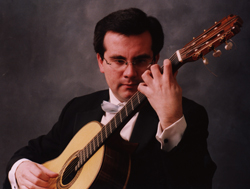by Mike Telin

“They all wrote in the romantic style and at that period of time, the classical guitar school in South America was very influenced by the Spanish school. Many Spanish guitar players went to Buenos Aires and began to develop and spread the technique as well as the music of this period across Latin America. I’ve been reading the old newspapers about those concerts and the reviews and all of the composer/players on this program were very successful at that time.”
On Saturday, November 23 beginning at 7:30 pm in Plymouth Church in Shaker Heights, the Cleveland Classical Guitar Society presents Carlos Pérez in a concert featuring the music ofAntonio Jiménez Manjón, Emilio Pujol, Tomás Damas, Agustin Barrios, Julio Sagreras and Ernesto Nazareth. As part of CCGS’s Educational Outreach programs, middle school students from Buchtel Community Learning Center of Akron will give a special guitar orchestra performance beginning at 6:50 pm.
What captivates Perez about that period of time is that we often think that communication between different parts of the world was not as common as it is today. “We do have all of these wonderful communications systems now, but that was also a very active period of time.”
Perez will begin Saturday’s program with Antonio Jiménez Manjón’s Dos Mazurkas and he says that Manjón is a good example of the classical guitar migration. “He was born in Spain and became blind at thirteen. He moved to Argentina and started to concertize extensively all over Latin America. He was married to a pianist who helped him write and publish many of his compositions as well as guitar etudes and methods.”
He also points out that most of the composers represented on his program were active during a period of time when musical styles were going in many different directions all over the world. “However, in terms of harmony, the music of these composers can seem a little bit old fashioned for that time. For example, in the 1920’s, when we have all of the European composers writing music that was more experimental, but at the same time there was a very strong taste for the music that was inspired by the romantic language. This music was strongly rooted in the music of Chopin. For example in the case of Ernesto Nazareth, Chopin was his idol. Nazareth mixed music that was a little bit old fashioned with Latin American rhythms. So it was a new language that had its roots in the nineteenth century but it also has a flavor that I think is refreshing.”
Has the South American classical guitar school changed since its arrival from Spain? “Yes, as it has all over the world. It has developed in terms of repertoire and technique. And the instruments have also developed in different directions in the way they are built. In general my preference is for an instrument that has clarity in the sound and is capable of producing a nice cantabile lines — especially when it comes to nineteenth century repertoire. I think the history of guitar making is wonderful because it’s so related to the music and the necessity that composers and players had in terms of developing their careers.”
A dedicated teacher, Perez says he finds that teaching helps him to improve as a player. “Yes, absolutely I do. When students come with problems we have to figure out how to solve those problems, and when you are teaching it is necessary to express your ideas clearly to the students — and that helps a lot in rethinking your own concepts.”
Why did Perez choose the Guitar? “My father played so it was always in our home. He didn’t play classical but rather traditional folk music. And we had many friends who would visit in order to play music as well. When I was very young, four or five years old, I started to imitate him. I started to study classical guitar a little later, around thirteen or fourteen.”
Perez recalls hearing recordings of classical guitar masters like Segovia, John Williams and Julian Bream for the first time, “My father is a fanatic for all styles of music, but when I heard recordings of the classical pieces, I was so impressed at how the guitar could make those sounds that I couldn’t believe it was the same instrument that I played. I wanted to study and find a teacher and try to play that music.”
And what kind of music does he listen to at home? “Mostly classical, not as an academic exercise, but simply because I like it very much. Although I do listen and like all kinds of music, like folkloric and jazz. Yes, I do enjoy different styles of music and I have preferences for the sub-styles as well. When there is an artist of any style who can give a nice message, then I find that to be inspiring.”
Carlos Perez has recently released a new CD of transcriptions of Bach’s Cello Suites nos. 2, 3, and 4. Musical examples and purchasing information can be found on his Web site.
Published on ClevelandClassical.com November 19, 2013
Click here for a printable version of this article.


